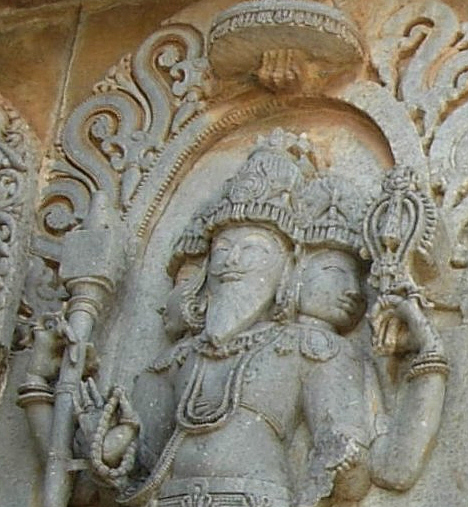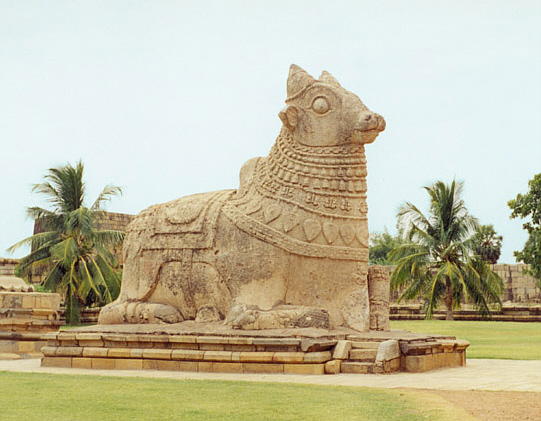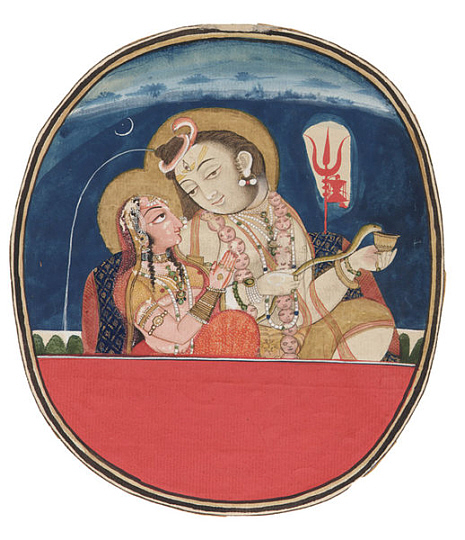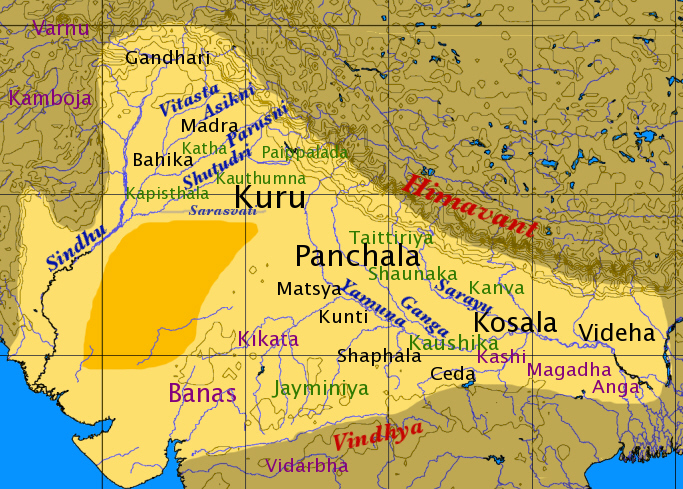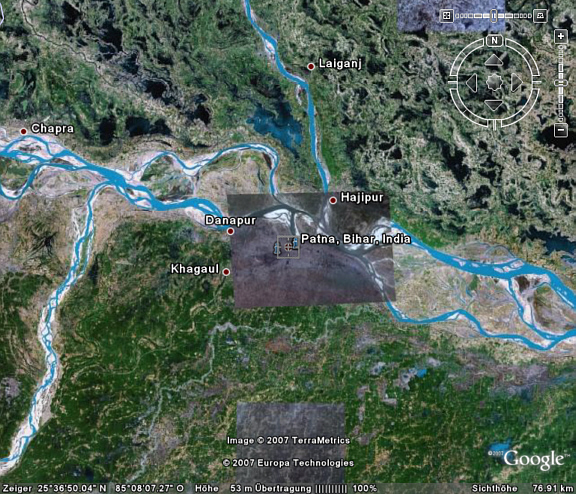| "Paṭnā (Hindi: पटना)
is the capital of the Indian state of Bihar (Hindi: बिहार, Urdu: بہار),
and one of the oldest continuously inhabited places in the world.
Megasthenes (Μεγασθενής) (350 BCE-290 BCE), in his book Indica has
mentioned that the city of Palibothra (Pataliputra, modern day
Patna) was situated on the confluence of the rivers Ganges and
Arennovoas (Sonabhadra - Hiranyawah) and was 9 miles long and 1.75
miles wide. The
modern city of Patna lies on the southern bank of the Ganges
(गंगा), as it
flows past with the combined waters of the rivers Ghagra, Son and Gandak.
At the point where the city is located, the sacred Ganges looks more sea
than river: mighty, wide and never-ending.
A bustling city of 1,200,000
people, the city is approximately 15 km long and 5 km to 7 km wide.
The Buddhist and Jain pilgrim
centres of Vaishali, Rajgir or Rajgriha, Nalanda, Bodhgaya, and Pawapuri
are all nearby. Patna is a sacred city for Sikhs also. Their tenth and
last "human" guru, Guru Gobind Singh (Punjabi: ਗੁਰੂ ਗੋਬਿੰਦ ਸਿੰਘ), was
born here. It is the ideal gateway for all the places on this circuit.
The monuments in and around the city take one down the history to its
glorious past.
Apart from being the
administrative centre of the state and its historic importance, the city
is also a major educational centre and medical centre. Its the epicentre
for all the students from Bihar preparing for various competitive
examinations. Various educational institutions are coming up here.
The walled old area, called
Patna City by the locals, is also a major trading centre.
Origin of name
The appellation Patna is
etymologically derived from Patan, the name of the Hindu goddess
Patan devi. Another theory says the name comes from Pattan, or a port in
Sanskrit since the city, located near the confluence of four rivers, has
been a thriving river port.
The city has been known by
various names during its more than two millennia long existence—Pataligram,
Pataliputra, Kusumpur, Pushpapura, Azimabad, and the present day Patna.
It got its name of Patna during the reign of Sher Shah Suri, a Bihari
ruler who has the distinction of making the only interruption to the
long rule of Mughals. His tomb is at Sasaram, a place near to Patna.
History of Patna
Legend ascribes the origin of Patna to a
mythological king Putraka who created Patna by magic for his queen
Patali, literally Trumpet flower, which gives it its ancient name
Pataligram. It is said that in honour of the first born to the queen,
the city was named Pataliputra. Gram is the Sanskrit for village
and Putra means son.
From a scientific history
perspective, it would be appropriate to surmise that the history of
Patna started around the year 490 BC when Ajatashatru, the king of
Magadh, wanted to shift his capital from the hilly Rajgriha to a more
strategically located place to combat the Licchavis of Vaishali. He
chose the site on the bank of Ganges and fortified the area. From that
time, the city has had a continuous history, a record claimed by few
cities in the world. Gautam Buddha passed through this place in the last
year of his life, and he had prophesized a great future for this place,
but at the same time, he predicted its ruin from flood, fire, and feud.
With the rise of the Mauryan
empire, the place became the seat of power and nerve centre of the
sub-continent. From Pataliputra, the famed emperor Chandragupta Maurya
(a contemporary of Alexander) ruled a vast empire, stretching from the
Bay of Bengal to Afghanistan.
Early Mauryan Pataliputra was
mostly built with wooden structures. Emperor Ashoka, the grandson of
Chandragupta Maurya, transformed the wooden capital into a stone
construction around 273 BC. Chinese scholar Fa Hein
(法顯), who
visited India sometime around A.D. 399-414, has given a vivid
description of the stone structures in his travelogue.
Megasthenes (Μεγασθενής) ,
Greek historian and ambassador to the court of Chandragupta gives the
first written account of Patliputra. Much later, a number of Chinese
travellers came to India in pursuit of knowledge and recorded their
observation about Pataliputra in their travelogues.
In the years that followed,
the city saw many dynasties ruling the Indian subcontinent from here. It
saw the rules of the Gupta empire and the Pala kings. However, it never
reached the glory that it had under the Mauryas.
With the disintegration of the
Gupta empire, Patna passed through uncertain times. Bakhtiar Khilji
(Persian اختيار الدين محمد بن بختيار الخلجي, Bengali ইখতিয়ার উদ্দিন
মুহম্মদ বখতিয়ার খলজী), captured Bihar in the 12th century AD and
destroyed many ancient seats of learning, Patna lost its prestige as the
political and cultural center of India.
The Mughal (Persian:
سلطنت مغولی هند , Urdu: مغلیہ سلطنت) period
was a period of unremarkable provincial administration from Delhi. The
most remarkable period during these times was under Sher Shah Suri
(Pashto/Persian:
شیر شاه سورى ) who revived Patna in the
middle of the 16th century. He visualised a fort and a town on the banks
of Ganga. Sher Shah's fort in Patna does not survive, but the mosque
built in Afghan architectural style survives.
Mughal emperor Akbar (Persian:
جلال الدین محمد اکبر ) came to Patna in 1574
to crush the Afghan Chief Daud Khan. Akbar's Secretary of State and
author of Ain-i-Akbari refers to Patna as a flourishing centre for
paper, stone and glass industries. He also refers to the high quality of
numerous strains of rice grown in Patna famous as Patna rice in Europe.
Mughal Emperor Aurangzeb
(Persian:
اورنگزیب, ) acceded to the request of his
favourite grandson Prince Muhammad Azim to rename Patna as Azimabad, in
1704 while Azim was in Patna as the subedar. However, very little
changed during this period other than the name.
With the decline of Mughal
empire, Patna moved into the hands of the Nawabs (Urdu: نواب, Hindi:
नवाब) of Bengal, who levied a heavy tax on the populace but allowed it
to flourish as a commercial centre.
During 17th century, Patna became a centre of
international trade. The British started with a factory in Patna in 1620
for trading in calico and silk. Soon it became a trading centre for
saltpetre, urging other Europeans—French, Danes, Dutch and Portuguese—to
compete in the lucrative business. Peter Mundy, writing in 1632, calls
this place, "the greatest mart of the eastern region".
After the decisive Battle of
Buxar (बक्सर) (1765), Patna fell in the hands of the East India Company
and continued as a trading centre.
In 1912, Patna became of the
capital of Orissa Province and Bihâr when Bengal Presidency was
partitioned. It soon emerged as an important and strategic centre. A
number of imposing structures were constructed by the British. Credit
for designing the massive and majestic buildings of colonial Patna goes
to the architect, I. F. Munnings. Most of these buildings reflect either
Indo-Saracenic influence (like Patna Museum and the state Assembly), or
overt Renaissance influence like the Raj Bhawan and the High Court. Some
buildings, like the General Post Office (GPO) and the Old Secretariat
bear pseudo-Renaissance influence. Some say, the experience gained in
building the new capital area of Patna proved very useful in building
the imperial capital of New Delhi.
Patna is important seat of
business in eastern part of India, major trading centre of cotton,
tusser, readymade garments, now it emerging as a big centre of higher
education as got. has started Chankya Law University, BIT Mesra
Extension Centre etc. There are several prestigious educational
institutions in Patna like Patna College, Patna Women's College, Patna
Science College, Bihar National College, Bihar College of Engineering,
now National Institute of Technology, Patna, Patna Medical College
(formerly, Prince of Wales Medical College), Nalanda Medical College,
Patna Dental College and the Bihar Veterinary College. A new IIT is
coming up near Patna. Also the prestigious IGIMS is starting medical
education in the near future. A few private medical & engineering
colleges are also coming up in the near future.
Orissa was created as a
separate province in 1935. Patna continued as the capital of Bihar
province under the British Raj.
Patna played a major role in
the Indian independence struggle. Most notable are the Champaran
movement against the Indigo plantation and the 1942 Quit India Movement.
Patna continued to be the
capital of the state of Bihar after independence in 1947, though Bihar
itself was partitioned again in 2000 when Jharkhand (Hindi: झारखंड,
Bengali: ঝাড়খণ্ড) was carved out as a separate state of the Indian
union. Geography
Patna is located on the south
bank of the Ganges River, called Ganga locally. Patna has a very long
riverline, and it is surrounded on three sides by rivers—the Ganga, Sone,
and Poonpun (also spelt Punpun). Just to the north of Patna across the
river Ganga flows the river Gandak making it a unique place having four
largish rivers in its vicinity. It is the largest riverine city in the
world.
The bridge over the river
Ganga, named after Mohandas Gandhi, is 5850m long is said to be the
longest single river bridge in the world.
- Altitude: 53 meters
- Temperature: Summer
43 °C to 21 °C, Winter 20 °C to 5 °C
- Rainfall (average): 1,200
mm
Climate
In Patna, as in most of Bihar,
the summer temperatures rise very high as the hot tropical sun beats
down with all its intensity coupled with a heat wave which though is not
as severe as say in Delhi (Hindi:
दिल्ली, Urdu:
دہلی or دلّی, Punjabi:
ਦਿੱਲੀ). The
city, being near four large rivers, experiences a rather high humidity
throughout the year.
The summer begins in April and
peaks in June/July with the temperature soaring up to 46° C till the
moisture laden monsoon wind bring some much-needed relief to the parched
fields. The rains last through August & September and continue into
early October. The northern Indian winters bring bitter cold nights and
sunny days to Patna from November to February till the arrival of the
spring that brings the weather to a full cycle.
The local almanac divides the
year into six seasons of roughly two months each. Apart from the usual
four seasons: Summer, Monsoon, Winter and Spring, you may add mild
winter between Monsoon and Winter and Mild summer just before the
onslaught of the severe north Indian summer.
Demographics
The population of Patna is over
1,285,470 (2001 census), which has grown from 917,243 in the 1991
census. The population density is 1132 persons per square kilometre.
There are 839 females to every 1,000 males. Overall Literacy rate is
62.9%, and female Literacy rate is 50.8%. Source – District Elementary
Education Report Card 2004 of National Institute of Educational Planning
and Administration, New Delhi (www.eduinfoindia.net)
Patna has a moderate crime
rate. The main jail is Beur Jail.
Many languages are spoken in
Patna. Hindi is the official language of the state of Bihar. Thanks to
the British influence since early days, English is also spoken
extensively.
The native dialect is Magahi (मगही).
Other dialects from other regions of Bihar spoken widely in Patna are
Angika (अङ्गिका or अंगिका), Bhojpuri (भोजपुरी), and Maithili (मैथिली).
Other languages spoken in Patna include Urdu (اردو), Bengali (বাংলা),
and Oriya (ଓଡ଼ିଆ)."
[Quelle:
http://en.wikipedia.org/wiki/Patna. -- Zugriff am 2007-03-13]
|

